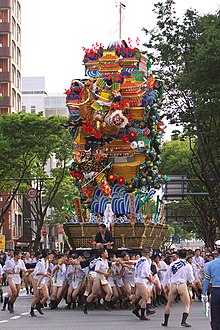Hakata Gion Yamakasa
The Hakata-Gion-Yamakasa ( Japanese 博 多 祇 園 山 笠 ) is a Japanese folk festival in Hakata, a district of Fukuoka . It is celebrated annually around the Kushida Shrine from July 1st to 15th and is famous for its large "bearers" that weigh about a ton and that locals race through the streets of Hakata. The festival is probably over 770 years old and attracts around one million spectators every year. It was named an Important Intangible Folk Heritage by Japan's Ministry of the Environment in 1979 . In 2016 it was included in the UNESCO list of "Intangible Cultural Heritage" with 32 other Matsuri because of the large, elaborately manufactured floats.
They carry
The festively decorated stretchers are called Yamakasa ( 山 笠 ) and are divided into two groups. The Kakiyama ( 舁 き 山 : "carrying mountain") are carried daily through the city of Hakata between July 10th and 15th. They are about three meters high, show a historical or mythical figure as a large doll and are also often decorated with pine branches.
The Kazariyama ( 飾 り 山 : "decoration mountain") usually stay at their exhibition locations throughout the festival. They are usually over ten meters high and richly decorated with dolls and other props. The dolls are made beforehand by Hakata's doll masters and attached to the Kazariyama in such a way that they tell a story. In recent years, some non-traditional references, such as Japanese TV series or Disney films, have also been added to the Kazariyama themes .
The Kazariyama from Kamikawabata-toori Street is an exception, as it is the only Kazariyama to be worn. For the three most important events, the Oiyamanarashi, Shudanyamamise and Oiyama , the huge Kazariyama is carried by the residents of the street after the Kakiyama .
Each year 7 Kakiyama are produced by one of Hakata's seven districts. Only three of the districts are also building a Kazariyama for the festival. The remainder of the 14 Kazariyama are commissioned annually by larger business associations in Fukuoka.
Although the greatest fascination these days comes from the race among the districts with their kakiyama , the origin of the festival is a religious ceremony. The Kushida Shrine and the Jōten Temple still play an important role today, and the festival is dedicated to Hakata's patron gods, including Susanoo-no-Mikoto in particular.
Events
In addition to countless smaller events, the most important ones take place between July 10th and 15th:
- July 10: Nagaregaki
- July 11th: Asayama
- July 11th: Tanagaregaki
- July 12th: Oiyamanarashi
- July 13: Shudanyamamise
- July 14th: second Nagaregaki
- July 15: Oiyama
history
The exact origin of the festival is not known, which suggests that the tradition is very old. There are similarities with the Buddhist Segaki ritual as performed in parts of Kyushu . Legend has it that Buddhist monk Enni Ben'en Hakata rescued an epidemic in 1241 by sprinkling the population with holy water while standing on a Segaki-dana shelf carried through Hakata by the townspeople. The festival is therefore an imitation of this event and a ceremony of thanks to the monk Enni Ben'en, who became high priest of the Jōten temple and the Kushida shrine after 1241. Both play an important role during the festivities today.
Before 1898, Kakiyama and Kazariyama were still one and the same and were only called Yamakasa . The great Yamakasa did not yet have dolls and were often decorated with small temples. But when the low-hanging electrical wiring in Hakata increased towards the end of the 19th century, the Yamakasa no longer fit underneath. After several incidents of vandalism on the lines, Fukuoka's magistrate decided that the Yamakasa should be made smaller. So that the districts are still the big Yamakasa could customize as status symbols that were Kazariyama addition to the Kakiyama introduced.
See also
Web links
- Hakata Gion Yamakasa Homepage (Japanese)
- Hakata-Gion-Yamakasa Portal: Yamakasa-Navi (German)
- Hakata Gion Yamakasa NHK
Individual evidence
- ↑ Hakata Gion Yamakasa Festival . Japan National Tourism Organization . Archived from the original on February 18, 2011. Info: The archive link was automatically inserted and has not yet been checked. Please check the original and archive link according to the instructions and then remove this notice. Retrieved March 20, 2011.
- ↑ Hakata Gion Yamakasa . Fukuoka City . Retrieved March 20, 2011.
- ^ Database of Registered National Cultural Properties . Agency for Cultural Affairs . Archived from the original on August 1, 2012. Info: The archive link was automatically inserted and not yet checked. Please check the original and archive link according to the instructions and then remove this notice. Retrieved March 20, 2011.
- ↑ Hakata Gion Yamakasa Festival Registered as UNESCO Intangible Cultural Heritage! - Fukuoka Convention & Visitors Bureau. Retrieved January 1, 2018 .
